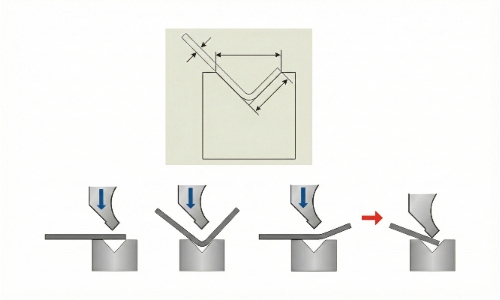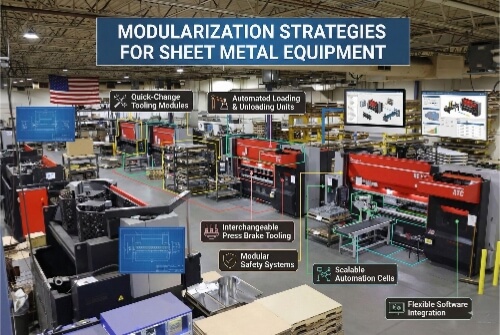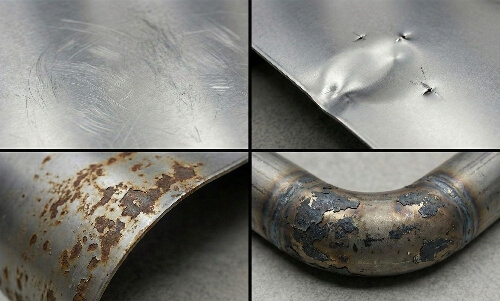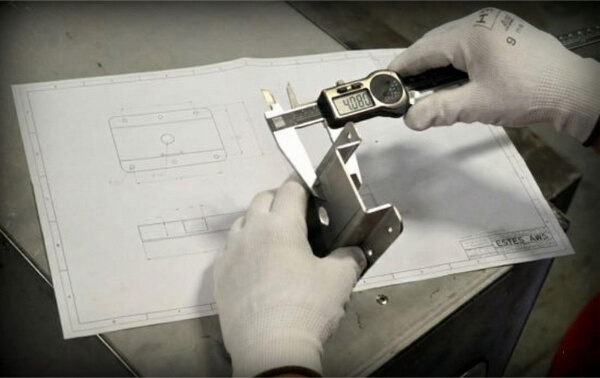No sector da metalomecânica, as pessoas confundem frequentemente fresas e tornos. Isto leva a problemas na escolha da máquina correta. Para evitar isso, é necessário saber como funcionam estas duas máquinas e o que as torna diferentes. Esta publicação explica-o de forma clara, sem pormenores adicionais. Vamos manter a simplicidade e mostrar quando usar cada uma delas.
Uma fresadora utiliza uma ferramenta giratória para cortar e moldar o material, enquanto um torno gira o material e molda-o com uma ferramenta fixa. As fresas são melhores para peças planas, complexas ou angulares, enquanto os tornos funcionam melhor para formas redondas, cilíndricas ou roscadas. Saber quando utilizar cada máquina pode ajudá-lo a poupar tempo e a evitar erros.
Ambas as máquinas moldam o metal. Mas a forma como funcionam é completamente diferente. Agora, explica como funciona cada uma das máquinas e quando devem ser utilizadas.
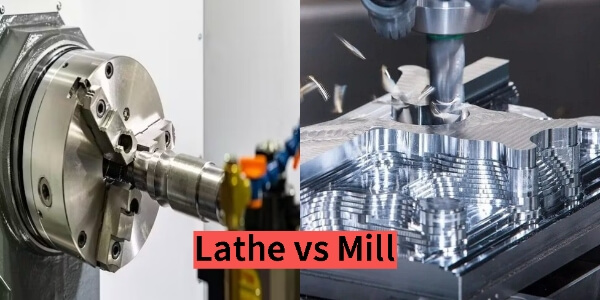
O que é um moinho?
Uma fresa é uma máquina que corta material sólido utilizando uma ferramenta rotativa. A ferramenta roda a alta velocidade enquanto a peça permanece imóvel. Remove material para criar superfícies planas, ranhuras e orifícios. Isto torna-a útil para muitas peças que necessitam de cantos afiados, formas complexas ou caraterísticas detalhadas.
Uma fresadora utiliza fresas rotativas para remover material. A peça de trabalho é fixada a uma mesa que se pode mover em várias direcções - X (da esquerda para a direita), Y (da frente para trás) e Z (para cima e para baixo). A ferramenta de corte gira e desloca-se pela superfície. Esta configuração permite que as fresadoras criem faces planas, bolsas, ranhuras, contornos e furos.
Tipos de fresadoras
Existem vários tipos de fresadoras. Cada uma tem uma configuração diferente.
- Moinho vertical: A ferramenta de corte aponta para baixo. A mesa desloca-se em X e Y, e a cabeça desloca-se em Z. Estes são os tipos mais comuns e são bons para a maioria dos trabalhos.
- Moinho horizontal: A ferramenta aponta para o lado. É melhor para cortar ranhuras profundas ou materiais pesados. Estas são mais utilizadas na produção.
- Fresadora CNC: Esta é uma fresadora controlada por computador. Pode fabricar peças complexas com elevada precisão. Funciona a partir de um programa digital.
- Moinho manual: Este tipo é acionado à mão. É utilizado para tarefas simples ou pequenos lotes de trabalho.
- Moinho de Cama: A cabeça permanece fixa e a mesa move-se para cima e para baixo. É utilizada para peças pesadas ou de grandes dimensões.
Vantagens e desvantagens
Vantagens:
- Ótimo para peças com superfícies planas, ranhuras e orifícios
- Pode tratar cortes complexos e pormenorizados
- Trabalha com muitos tipos de materiais
- As fresadoras CNC oferecem elevada repetibilidade e tolerância apertada
Desvantagens:
- Mais lento do que algumas outras máquinas para formas simples
- Menos eficaz para peças redondas
- A configuração pode demorar algum tempo, especialmente para trabalhos complexos
Aplicações comuns da fresagem
A fresagem é utilizada em muitas indústrias. Desempenha um papel fundamental na metalurgia, aeroespacial, automóvel e fabrico de ferramentas.
Algumas aplicações típicas:
- Fabricação colchetes, coberturase caixas
- Corte de ranhuras e ranhuras
- Perfuração e furos de rosca
- Criação de moldes e matrizes
- Maquinação de dispositivos ou protótipos personalizados
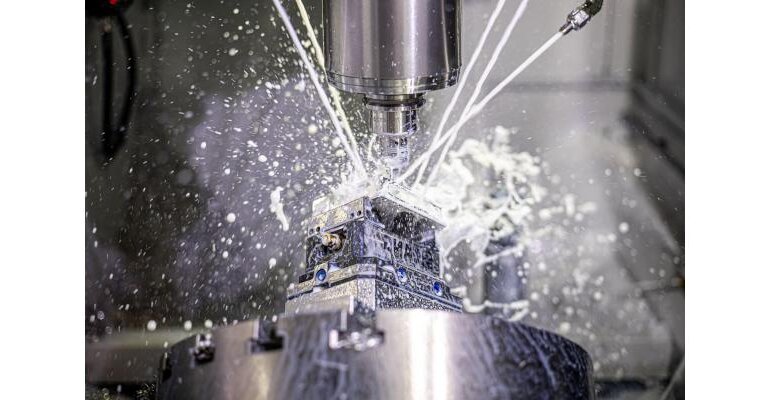
O que é um torno?
Um torno é uma máquina que roda uma peça enquanto uma ferramenta de corte fixa remove material. Esta ação de rotação torna-o ideal para moldar objectos redondos ou cilíndricos. Os tornos são uma das máquinas mais antigas e mais utilizadas na metalomecânica.
Um torno funciona segurando uma peça de trabalho num mandril rotativo. A ferramenta de corte permanece imóvel mas move-se ao longo da peça em rotação. A ferramenta corta as camadas à medida que o material gira para atingir a forma pretendida.
Os tornos podem efetuar várias operações:
- Girando: reduz o diâmetro
- Faceamento: alisa a extremidade da peça
- Tedioso: alarga um buraco
- Ranhura: corta um canal estreito
- Rosqueamento: cria roscas externas ou internas
Tipos de tornos
Os tornos existem em diferentes tipos, consoante o seu funcionamento e o nível de automatização.
- Torno de motor: Um torno manual versátil utilizado para trabalhos de carácter geral. Funciona com volantes.
- Torno de torre: Concebida para a produção em série. Utiliza várias ferramentas montadas numa torre rotativa.
- Torno CNC: Utiliza o controlo por computador. É ideal para peças de precisão e produção de grande volume.
- Torno de bancada: Uma versão mais pequena para trabalhos ligeiros ou prototipagem.
- Torno suíço: Esta máquina é muito precisa e suporta peças longas e finas durante a maquinagem. É comum nas indústrias médica e eletrónica.
Vantagens e desvantagens
Vantagens:
- Excelente para o fabrico de peças redondas ou cilíndricas
- Pode efetuar várias operações numa única configuração
- Produz acabamentos de superfície lisos
- Os tornos CNC oferecem resultados rápidos e repetíveis
Desvantagens:
- Limitado a formas que rodam em torno de um centro
- Não é adequado para superfícies planas ou bolsas complexas
- A operação manual requer mão de obra especializada
Aplicações comuns do torneamento
O torneamento é utilizado sempre que as peças necessitem de perfis redondos, acabamentos limpos ou controlo apertado do diâmetro.
Algumas utilizações comuns:
- Eixos, pinos e hastes
- Buchas e rolamentos
- Acessórios para tubos e uniões
- Componentes roscados
- Peças para o sector automóvel e aeroespacial
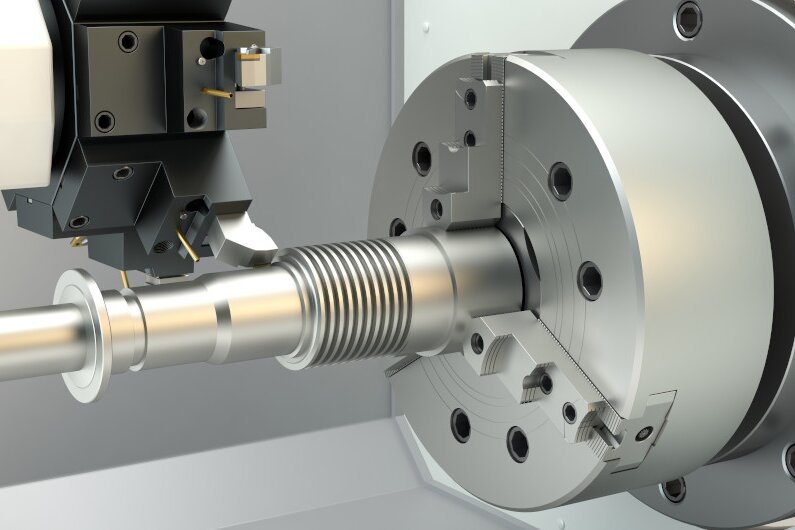
Principais diferenças entre fresas e tornos
Compreender as diferenças entre fresadoras e tornos ajuda-o a escolher a ferramenta certa. Abaixo estão as principais caraterísticas que os distinguem.
Como funcionam
Uma máquina de fresagem utiliza uma ferramenta de corte rotativa que se desloca através de uma peça fixa de material. A ferramenta faz o trabalho enquanto a peça permanece imóvel. Um torno funciona ao contrário. A peça gira e uma ferramenta de corte fixa dá-lhe forma enquanto gira. Esta única diferença altera a forma como cada máquina lida com o material.
Formas e peças ideais
As fresas são óptimas para peças com superfícies planas, orifícios, ranhuras e caraterísticas detalhadas. São adequadas para criar formas que necessitem de cantos ou ângulos. Os tornos são melhores para fazer peças redondas com um diâmetro constante, como veios, tubos ou casquilhos. O torno é provavelmente a melhor escolha se a sua peça for maioritariamente redonda.
Precisão e acabamento
Ambas as máquinas podem produzir peças muito precisas, mas cada uma tem os seus pontos fortes. As fresas são fortes a fazer superfícies planas precisas e cortes pormenorizados. São óptimas para tolerâncias apertadas em furos e padrões. Os tornos são ideais quando a circularidade, os acabamentos suaves ou os diâmetros exactos são mais importantes. São excelentes para tornear, roscar e fazer curvas limpas e uniformes.
Eficiência e tempo de ciclo
Os tornos são frequentemente mais rápidos para peças simples e redondas. Podem completar rapidamente as operações de torneamento numa única configuração. As fresas normalmente demoram mais tempo, especialmente para peças com muitas caraterísticas. As formas complexas podem necessitar de várias configurações e mudanças de ferramentas. Para a produção de grande volume de peças redondas, os tornos têm frequentemente vantagem em termos de velocidade.
Acabamento da superfície e tolerâncias
Os tornos proporcionam normalmente melhores acabamentos de superfície em peças redondas. Podem produzir superfícies mais suaves e limpas numa só passagem. As fresas também podem dar bons acabamentos, dependendo da ferramenta, da velocidade e do material. As fresas são mais precisas em termos de planicidade e localização de furos, enquanto os tornos são melhores em termos de circularidade e concentricidade.
Ferramentas de corte
As fresas utilizam ferramentas rotativas, tais como fresas de topo, fresas de facear e brocas. Estas ferramentas têm muitas formas para cortar ranhuras, orifícios e bolsas. Os tornos utilizam ferramentas fixas, como pastilhas de metal duro ou fresas de aço rápido. A forma da ferramenta permanece a mesma e a peça de trabalho roda. As fresas necessitam de mais mudanças de ferramenta. Os tornos fazem frequentemente mais trabalho com menos ferramentas.
Considerações de custo
As fresadoras tendem a custar mais do que os tornos. Utilizam configurações e ferramentas mais complexas e tempos de ciclo mais longos para peças pormenorizadas. Os custos de manutenção e de ferramentas também são mais elevados. Os tornos são normalmente mais baratos para peças redondas simples. Se as suas peças são maioritariamente redondas, um torno poupa tempo e dinheiro. Para trabalhos mistos ou complexos, uma fresadora oferece mais flexibilidade.
Fresa vs Torno: Qual é que deve escolher?
A escolha entre uma fresadora e um torno depende do desenho da peça, do material, do orçamento e do número de peças que precisa de fabricar. Eis os principais factores a considerar.
Tipo de material e dureza
Ambas as máquinas podem cortar materiais comuns como alumínio, aço, latão e plástico. Para materiais mais duros, como aço inoxidável ou titânio, são necessárias ferramentas fortes e as velocidades corretas. Os tornos podem ter problemas com barras longas e duras se não estiverem bem apoiadas. As fresas são melhores para lidar com material plano espesso e materiais em folha.
Forma e desenho da peça
Uma fresa é normalmente a melhor opção se a peça tiver superfícies planas, orifícios ou formas pormenorizadas. As fresadoras podem mover-se em diferentes direcções e utilizar muitas ferramentas, o que as torna adequadas para dar forma a peças complexas. Os tornos funcionam melhor para formas redondas simples, como hastes, pinos e anéis. Não foram concebidos para ângulos ou cortes descentrados.
Velocidade e quantidade
Os tornos são mais rápidos para fazer muitas peças redondas. Necessitam de menos configurações e podem transformar peças rapidamente. Isto torna-os óptimos para trabalhos de grande volume, como parafusos ou casquilhos. As fresadoras demoram mais tempo mas oferecem mais flexibilidade. São melhores quando é necessário um lote pequeno ou médio de peças com caraterísticas detalhadas. As máquinas CNC podem aumentar a velocidade de ambos, mas os tornos continuam a liderar em termos de velocidade de torneamento.
Custo e Eficiência
Os tornos são mais eficientes se o objetivo for fazer muitas peças redondas a baixo custo. Utilizam menos ferramentas, necessitam de menos tempo de preparação e, normalmente, funcionam mais depressa. As fresadoras custam mais por peça, mas são melhores quando são necessários desenhos personalizados ou caraterísticas mais complexas. Uma fresadora é um melhor investimento a longo prazo se o seu trabalho muda frequentemente ou requer formas diferentes. Opte por um torno se o objetivo for peças redondas e uma produção elevada.
Conclusão
As fresas e os tornos são ambos ferramentas poderosas, mas têm objectivos diferentes. As fresas são melhores para superfícies planas, orifícios e formas complexas. Os tornos funcionam melhor para peças redondas, como veios e roscas. Se as suas peças são redondas e simples, opte por um torno. Se forem complexas e necessitarem de uma modelação precisa, escolha uma fresa. O desenho da peça, o material e as necessidades de produção devem orientar a sua escolha.
Precisa de ajuda para decidir qual o melhor método de maquinagem para as suas peças? Contactar a nossa equipa. Analisaremos os seus desenhos e recomendaremos o processo mais eficiente e económico.
Olá, chamo-me Kevin Lee

Nos últimos 10 anos, tenho estado imerso em várias formas de fabrico de chapas metálicas, partilhando aqui ideias interessantes a partir das minhas experiências em diversas oficinas.
Entrar em contacto

Kevin Lee
Tenho mais de dez anos de experiência profissional no fabrico de chapas metálicas, especializando-me em corte a laser, dobragem, soldadura e técnicas de tratamento de superfícies. Como Diretor Técnico da Shengen, estou empenhado em resolver desafios complexos de fabrico e em promover a inovação e a qualidade em cada projeto.

